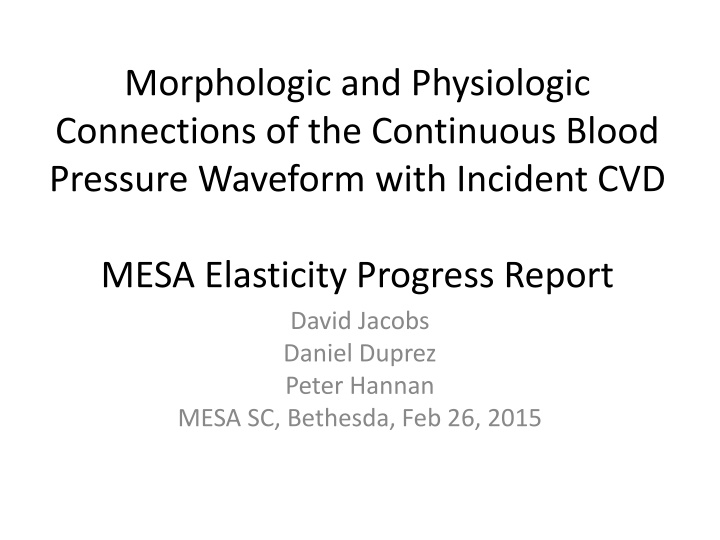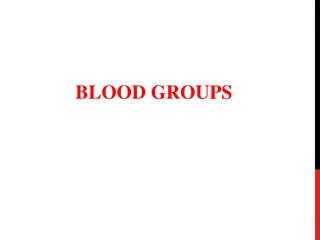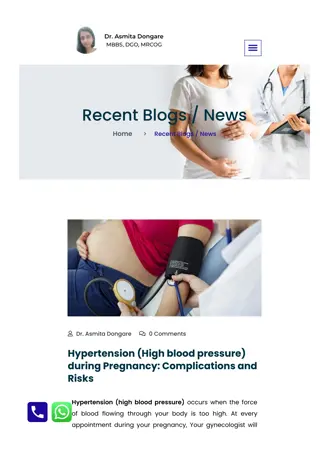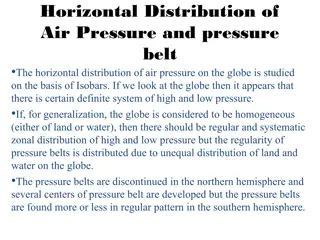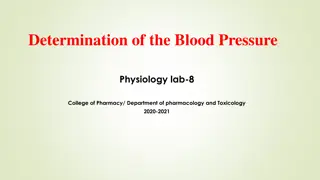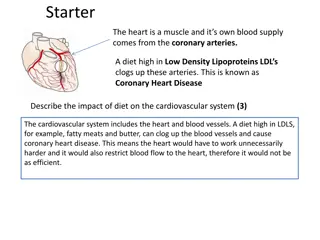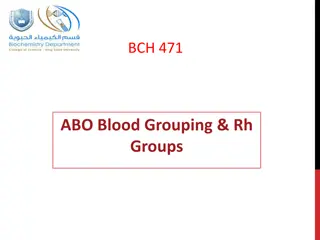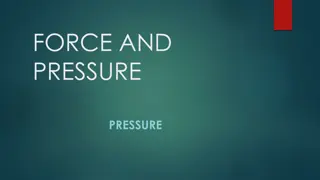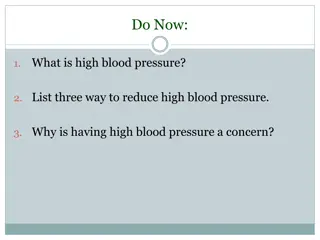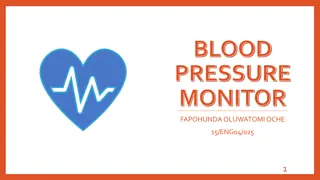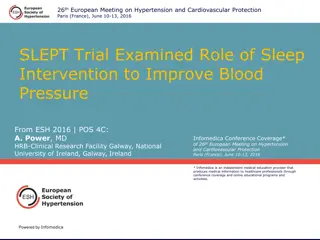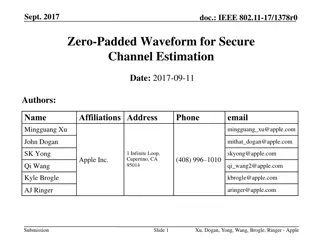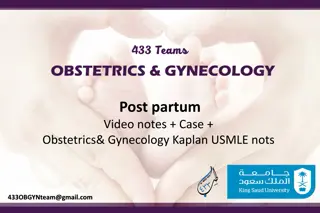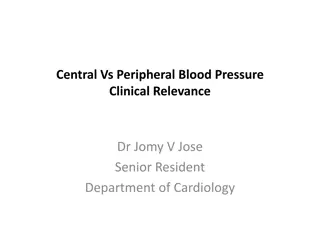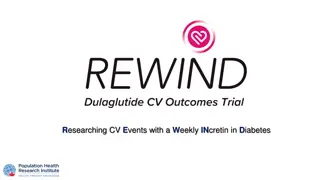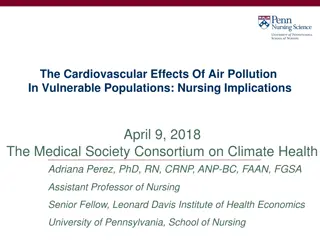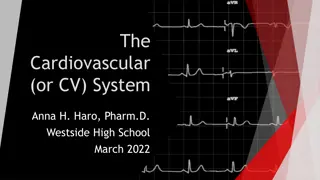Morphologic and Physiologic Connections in Blood Pressure Waveforms for Cardiovascular Event Prediction
This report discusses the morphologic and physiologic connections in continuous blood pressure waveforms and their association with incident cardiovascular events. The study aims to assess if changes in arterial elasticity contribute to predicting CVD events and explores additional measures derived from radial artery pulse waveforms. Key topics include waveform analysis, ventriculo-vascular coupling, and markers of cardiovascular function. Various images illustrate waveform changes and physiological events related to cardiovascular health.
Download Presentation

Please find below an Image/Link to download the presentation.
The content on the website is provided AS IS for your information and personal use only. It may not be sold, licensed, or shared on other websites without obtaining consent from the author.If you encounter any issues during the download, it is possible that the publisher has removed the file from their server.
You are allowed to download the files provided on this website for personal or commercial use, subject to the condition that they are used lawfully. All files are the property of their respective owners.
The content on the website is provided AS IS for your information and personal use only. It may not be sold, licensed, or shared on other websites without obtaining consent from the author.
E N D
Presentation Transcript
Morphologic and Physiologic Connections of the Continuous Blood Pressure Waveform with Incident CVD MESA Elasticity Progress Report David Jacobs Daniel Duprez Peter Hannan MESA SC, Bethesda, Feb 26, 2015
Aims 1)To assess whether 10-year change in LAE and SAE adds to prediction of clinical cardiovascular (CVD) events Pending further analysis of Ex 5 data and events 2) To derive and assess additional measures from the digitized radial artery pulse waveform Presentation today We also introduce an alternate approach to NRI
CR-2000 Waveforms, 2000-2002 in an arbitrarily selected person Slope changes are clear and shape is homogeneous
Median Waveform Standardized to 1 second and 75-125 mmHg, removing both absolute BP and heart rate
Morphology Marking Time & Pressure at Waveform Curvature Changes Automatically mark early curvature, upslope pressure 100 (50% of excursion; short green triangle), left shoulder (red), peak (green), right shoulder (blue), dicrotic notch (both turquoise) by noting more than trivial maxima, minima, and inflection points (2ndderivative = 0)
Physiology: ventriculo-vascular coupling Time 0.0: opening of aortic valve (time delayed to radial pulse), end of IVCT, begin systolic upslope Arrow: Early curvature, time ~0.030, relatively unimpeded by reflection wave, strong ventricular action quickly overcomes afterload Green triangle: half the upward excursion Red vertical (left shoulder) and Green vertical (peak): slowing acceleration of pressure wave, status of LV contraction/LV volume combination during ejection, mixing forward/backward pressures
Physiology: ventriculo-vascular coupling (2) Blue vertical (right shoulder): probable point at which LV begins untwisting, ~pressure at central SBP Blue oblique: line connecting pressure 100 to pressure at right shoulder Turquoise verticals (dicrotic notch): D1 is aortic valve closure and beginning of IVRT, D2 ends IVRT, ~ time of mitral valve opening; D2 increase is reversing blood flow; backward pressure wave may persist and alter dicrotic notch shape D2 to about 0.9: LV untwisting and filling, 0.9 is the approximate beginning time of IVCT
Murgo Types Type A: Big excess on upslope (left), left shoulder is actually a separate peak, dip before peak, high right shoulder Type C: Left shoulder is part of continuous upslope, close to peak, then clear downslope and low right shoulder Type B: Dome (not shown) or flat top (Bb), left and right shoulders similar height, location of peak ambiguous (flat tops are about 1/3 of all MESA participants
Waveform as a Whole The waveform is coordinated , for example, time to max early curvature has correlation -0.15 with pressure at the right shoulder 0.10 with time between the left and right shoulders 0.17 with pressure difference at D2 minus D1 Information in the waveform is overlapping Measures based on one part of the waveform may actually reflect physiologic occurrences in another part
Radial artery augmentation index (AIx) Radial AIx may be defined as the ratio of pressures at the presumed 2ndto 1stcentral peak (peak/left shoulder for Murgo Type A, right shoulder/left shoulder for Murgo Type B, right shoulder/peak for Murgo Type C Alternately, because Murgo Type is ambiguous in about 1/3 of participants with flat waveform tops, radial AIx can be the ratio of pressures at the right shoulder/left shoulder, correlation with first def n 0.9. Radial AIx correlates -0.48 with pressure at D2 pressure at D1 -0.38 with HDI s C2R
Integrals: Slice and Sliver Detail sliver Slice: pie-slice with oblique base (line connecting pressure (eg 100) in upslope to pressure at right shoulder), including slice left of time of peak, slice right of time of peak, and full slice (slice left + slice right). Sliver: thin slice, toothpick shape, 'extra' bulge in left systole
Integrals: Slice and Sliver Detail Slice Left Slice: pie-slice with oblique base (line connecting pressure (eg 100) in upslope to pressure at right shoulder), including slice left of time of peak, slice right of time of peak, and full slice (slice left + slice right). Sliver: thin slice, toothpick shape, 'extra' bulge in left systole
Integrals: Slice and Sliver Detail Slice Right Slice: pie-slice with oblique base (line connecting pressure (eg 100) in upslope to pressure at right shoulder), including slice left of time of peak, slice right of time of peak, and full slice (slice left + slice right). Sliver: thin slice, toothpick shape, 'extra' bulge in left systole
Composite Measures: Deconvolutions HDI s C2R deconvolutes the distal end of the waveform from the near notch to near end of diastole into a decaying exponential + a dampened cosine C2R itself depends on 2 pressure time constants: general rate of decay and (often more strongly) rate of dampening of oscillations Lyn Brumback s PTC2 deconvolutes using a similar functional form from the peak to end diastole Both strongly predict incident events PTC2, C2R correlation = 0.63 PTC2, radial augmentation index = -0.53 HDI C2R defined over the range inflection (dotted verticals) around D1 to loss of monotonicity, most precise C2R among 20 start points over 10 beats PTC2 defined over peak to end diastole
Incidence Prediction: Testing Strategy We know that in MESA HDI s C2R is strongly predictive of all CVD outcomes We assume that the reflection waves are important adverse factors, at least partly reflected in the radial AIx The competence of the LV and the ability to overcome arterial afterload is testable Specific studies of different waveform measures against incident CVD help further describe (interpret p values cautiously)
Models and PHREG Prediction At risk: Incident total CVD (includes HF, PAD): Incident HF: Incident CHD or Stroke : Adjustment: Age, race, sex, height, heart rate, SBP, DBP, BP meds, BMI, smoking, cholesterol, HDL-C, TG, lipid meds, diabetes, CRP Waveform measures unit: 1 SD 6165 715 217 570
Associations with incident CVD, hazard ratio per SD of each predictor, separate regressions Total CVD HF Any stroke or CHD Continuous Predictor Radial AIx (P2/P1) HR (95% CI), p 1.11 (1.03-1.21) p=0.01 HR (95% CI), p 1.18 (1.02-1.36) p=0.03 HR (95% CI), p 1.10 (1.01-1.21) p=0.04 Slice right 0.80 (0.73-0.88) p<.0001 0.67 (0.57-0.79) p<.0001 0.85 (0.77-0.94) p=0.002 Vertical area peak to right shoulder 0.85 (0.79-0.92) p<.0001 0.71 (0.62-0.82) p<.0001 0.89 (0.82-0.98) p=0.01 Time of max early curvature 1.09 (1.01-1.17) p=0.02 1.21 (1.07-1.35) p=0.0017 1.04 (0.96-1.13) p=0.33 Time to reach upslope pressure 85 1.13 (1.04-1.22) p=0.003 1.28 (1.13-1.46) p=0.0002 1.07 (0.98-1.17) p=0.13 HDI's C2R 0.81 (0.73-0.89) p<.0001 0.82 (0.68-0.98) p=0.03 0.82 (0.73-0.92) p=0.0005
Associations with incident CVD, incidence density per 100 people followed 10.1 y by quartile of each predictor, separate regressions Total CVD Quartile Predictor Q1 Q2 Q3 Q4 Q4/Q1 HR Radial AIx (P2/P1) 7.3 8.3 10.7 10.5 HR=1.44 Slice right 11.5 10.2 8.1 7.2 HR=0.62 Vertical area peak to right shoulder HR=0.64 HF Any stroke or CHD Q1 Q2 Q3 Q4 Q4/Q1 HR 5.8 6.5 8.6 8.3 HR=1.43 8.3 8.0 6.6 6.4 HR=0.77 8.9 6.9 7.1 6.3 HR=0.70 Q1 Q2 Q3 Q4 Q4/Q1 HR 1.6 2.2 2.5 2.8 HR=1.70 3.4 2.7 1.9 1.3 HR=0.38 3.4 2.5 1.9 1.4 HR=0.40 11.6 9.3 8.3 7.5 Time of max early curvature 6.9 9.2 8.9 10.7 HR=1.56 8.0 10.0 8.1 10.9 HR=1.36 10.9 9.8 9.7 6.4 HR=0.59 1.6 2.0 2.6 3.0 HR=1.85 1.7 2.5 1.7 3.3 HR=1.96 2.7 2.3 2.4 1.6 HR=0.57 5.4 7.7 6.9 8.1 HR=1.51 6.4 8.2 6.6 8.1 HR=1.25 8.2 8 .0 8.0 5.1 HR=0.61 Time to reach upslope pressure 85 HDI's C2R
Associations with incident CVD, hazard ratio per SD of each predictor, joint regressions Total CVD HR (95% CI), p HF Any stroke or CHD HR (95% CI), p Continuous Predictor HR (95% CI), p Slice right 0.85 (0.78-0.93) p=0.0005 1.07 (1-1.15) p=0.05 0.85 (0.77-0.94) p=0.002 0.71 (0.60-0.83) p<.0001 1.19 (1.06-1.33) p=0.004 NS 0.89 (0.8-0.98) p=0.02 NS Time of max early curvature HDI's C2R 0.85 (0.76-0.95) p=0.004 Quartile Predictor Q1 Q2 Q3 Q4 Q4/Q1 HR 10.3 10.1 8.0 7.5 HR=0.73 6.8 9.1 8.7 10.4 HR=1.52 10.3 9.5 9.6 6.7 HR=0.65 Q1 Q2 Q3 Q4 Q4/Q1 HR 3.1 2.8 1.8 1.4 HR=0.43 1.6 1.9 2.4 2.8 HR=1.77 NS Q1 Q2 Q3 Q4 Q4/Q1 HR 7.9 7.9 6.4 6.4 HR=0.81 NS Slice right Time of max early curvature HDI's C2R 8.0 7.8 8.0 5.2 HR=0.66
Improvement in Prediction Probability Alternative to NRI Estimate Pbase: P(incidence|base model): no waveform predictors Estimate Palt: P(incidence|alternative model): including waveform predictors Reclassification probability is Palt Pbase: positive means reclassify up, negative means reclassify down Successful reclassification means that observed risk increases as Palt Pbase increases
Improvement in Prediction Probability (alternative to NRI), Total CVD % events Palt - Pbase prediction of Total CVD Pbase Quartile Reclass down Reclass Up Rel Risk 1 1.8 (15/822) 2.6 (19/719) 1.45 2 5.2 (42/805) 5.6 (41/736) 1.07 3 13.2 (100/757) 14.0 (110/785) 1.06 4 19.0 (151/795) 31.8 (237/746) 1.67 Total 9.7 (308/3179) 13.6 (407/2986) 1.41 Proportional hazards regression of observed total CVD on Palt Pbase, adjusted for Pbase : p<0.0001
Improvement in Prediction Probability (alternative to NRI), HF % events Palt - Pbase prediction of HF Pbase Quartile Reclass down Reclass Up Rel Risk 1 0.4 (3/839) 0.7 (5/702) 1.97 2 0.8 (7/898) 0.8 (5/643) 1 3 3.0 (26/874) 5.5 (37/668) 1.87 4 6.8 (59/863) 11.1 (75/678) 1.62 Total 2.7 (95/3474) 4.5 (122/2691) 1.66 Proportional hazards regression of observed HF on Palt Pbase, adjusted for Pbase : p=0.003
Improvement in Prediction Probability (alternative to NRI), any Stroke or CHD % events Palt - Pbase prediction of Stroke or CHD Pbase Quartile Reclass down Reclass Up Rel Risk 1 1.3 (10/790) 1.9 (14/751) 1.46 2 4.7 (37/796) 5.5 (41/745) 1.18 3 9.3 (67/718) 11.3 (93/824) 1.21 4 17.3 (132/763) 22.6 (176/778) 1.31 Total 8.0 (246/3067) 10.5 (324/3098) 1.30 Proportional hazards regression of observed Stroke or CHD on Palt Pbase, adjusted for Pbase : p<0.0001
Conclusion Radial AIx predicts arteriosclerotic disease and HF, yet there is more in the waveform that predicts future disease, in particular slice right and HDI s C2R The onset of systole is interesting as a measure of ventricular competence and its relation to afterload. It predicts HF. The waveform is coordinated, with different parts informing other parts. Multiple measures predict better than single measures, and their combination informs the biology. We continue to investigate HDI s C2R and related measures that are based on the waveform in diastole An important issue is whether the backward wave persists into diastole and alerts the shape of the DN.
Median Beat Method Median beats are computed by fitting a spline (Sfit$y) to each time- and pressure-standardized beat at each of 1000 millisec (TIM), then excluding individual beats for which ln(E/O) > 0.3 (K-L criterion, all beats accepted here)
Physiology: ventriculo-vascular coupling Time 0.0: opening of aortic valve, end of IVCT, begin systolic upslope Arrow: Early curvature, time ~0.030, relatively unimpeded by reflection wave, strong ventricular action quickly overcomes afterload Green triangle: half the upward excursion Red vertical (left shoulder) and Green vertical (peak): slowing acceleration of pressure wave, status of LV contraction/LV volume combination during ejection, mixing forward/backward Blue vertical (right shoulder): probable point at which LV begins untwisting, ~pressure at central SBP, hand influence above line connecting pressure 100 to pressure at right shoulder Turquoise verticals (dicrotic notch): D1 is aortic valve closure and beginning of IVRT, D2 ends IVRT, ~ time of mitral valve opening; D2 increase is reversing blood flow; backward pressure wave may persist and alter dicrotic notch shape Time D2 to about 0.9: LV untwisting and filling, 0.9 is the approximate beginning time of IVCT
Waveform as a Whole The waveform is coordinated , for example, time to max early curvature has correlation -0.15 with pressure at the right shoulder 0.10 with time between the left and right shoulders 0.17 with pressure difference at D2 minus D1 Composite measures reflect aspects that are not in the composite computation. For example HDI s C2R has correlation -0.42 with pressure at right shoulder -0.34 with time to peak -0.07 with time to max early curvature 0.41 with pressure difference at D2 minus D1 (included with C2R range) Information in the waveform is overlapping Measures based on one part of the waveform may actually reflect physiologic occurrences in another part Multiple measures should be studied and contrasted
Composite Measures: Integrals Vertical integrals: walls are perpendicular to time axis 0 to left shoulder, left shoulder to peak, peak to right shoulder, right shoulder to dicrotic notch
Composite Measures: Integrals (2) Slice: pie slice with oblique base (line connecting pressure (eg 100) in upslope to pressure at right shoulder), including slice left of time of peak, slice right of time of peak, and full slice (slice left + slice right). Slice right and full slice capture more of the waveform shape than does the radial augmentation index Sliver: thin slice, toothpick shape, 'extra' bulge in left systole Sliver and slice left predict incidence oppositely, but are explained when slice right is in the model.
